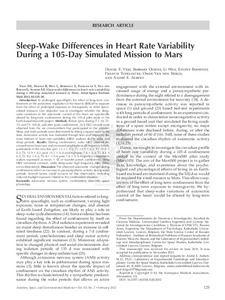Por favor, use este identificador para citar o enlazar este ítem:
https://repositorio.uca.edu.ar/handle/123456789/1652| Título: | Sleep-wake differences in heart rate variability during a 105-day simulated mission to Mars | Autor: | Vigo, Daniel Eduardo Ogrinz, Barbara Wan, Li Bersenev, Evgeny Tuerlinckx, Francis Van den Bergh, Omer Aubert, André E. |
Palabras clave: | CONFINAMIENTO; SISTEMA NERVIOSO; FISIOLOGIA; ESPACIO; SUEÑO | Fecha de publicación: | 2012 | Editorial: | Aerospace Medical Association | Cita: | Vigo, D.E., et al. Sleep-wake differences in heart rate variability during a 105-day simulated mission to Mars [en línea]. Preprint del documento publicado en Aviation Space and Environmental Medicine. 2012, 83 (2). doi:10.3357/ASEM.3120.2012. Disponible en: https://repositorio.uca.edu.ar/handle/123456789/1652 | Resumen: | Abstract: Introduction: In prolonged space flights the effect of long-term confinement on the autonomic regulation of the heart is difficult to separate from the effect of prolonged exposure to microgravity or other space-related stressors. Our objective was to investigate whether the sleep-wake variations in the autonomic control of the heart are specifically altered by long-term confinement during the 105-day pilot study of the earth-based Mars500 project. Methods: Twenty-four-hour EKG records were obtained before (pre), during (T1: 30, T2: 70 and T3: 100 days), and after (post) confinement in the six crew members that participated in the mission. Sleep and wake periods were determined by fitting a square wave to the data. Autonomic activity was evaluated through time and frequency domain indexes of heart rate variability (HRV) analysis in wake and sleep periods. Results: During confinement, wake HRV showed decreased mean heart rate and increased amplitude at all frequency levels, particularly in the very low (pre: 13.3 ± 0.2; T1: 13.9 ± 0.3; T2: 13.9 ± 0.2; T3: 13.9 ± 0.2; post: 13.2 ± 0.2), and high (pre: 7.6 ± 0.4; T1: 8.3 ± 0.5; T2: 8.2 ± 0.4; T3: 8.1 ± 0.4; post: 7.6 ± 0.3) frequency components (values expressed as mean ± SE of wavelet power coefficients). Sleep HRV remained constant, while sleep-wake high frequency HRV differences diminished. Discussion: The observed autonomic changes during confinement reflect an increase in parasympathetic activity during wake periods. Several factors could account for this observation, including reduced daylight exposure related to the confinement situation. | URI: | https://repositorio.uca.edu.ar/handle/123456789/1652 | ISSN: | 0095-6562 | Disciplina: | MEDICINA | DOI: | 10.3357/ASEM.3120.2012 | Derechos: | Acceso Abierto | Fuente: | Preprint del documento publicado en Aviation Space and Environmental Medicine. 2012, 83 (2) |
| Aparece en las colecciones: | Artículos |
Ficheros en este ítem:
| Fichero | Descripción | Tamaño | Formato | |
|---|---|---|---|---|
| sleep-wake-differences-heart-rate.pdf | 655,65 kB | Adobe PDF |  Visualizar/Abrir |
Visualizaciones de página(s)
185
comprobado en 30-abr-2024
Descarga(s)
290
comprobado en 30-abr-2024
Google ScholarTM
Ver en Google Scholar
Altmetric
Altmetric
Este ítem está sujeto a una Licencia Creative Commons

